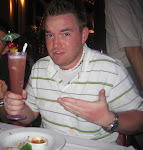

By Michael Stein
One of the newest (soon-to-be) neighbors on the Mid-Atlantic brew block is the duo, Jeff Hancock and Brandon Skall, co-owners of DC Brau Brewing. The District's first 21st Century production brewery will crank out kegs - the first to do so since the last keg came off Christian Heurich Brewing Company's line back in 1956. These young men with big plans are turning an old factory into a new production brewery in order to make beer for the fine people of Washington AND the District...and of course the Virginians and Marylanders who work daily in the district...and yes (sadly) even the kickballers and interns are welcomed to belly up to the bar for some DC Brau.
So while Washington and the District may remain two separate cities well into 2011, at least they'll have a beer (or three) to unite and bring them together. DC Brau will offer its three flagship craft beers in cans: the Public Ale (Pale/Amber hybrid), the Citizen (same recipe as the Public but fermented with a Belgian yeast strain) and Corruption Ale (an IPA).
Its usually difficult for a lowly homebrewer to give advice to the big bad head brewer for his forthcoming brewery. If not for lack of input, typically for lack of access to the "big guy." Sure you might see the head brewer at some major beer festivals of national scope, but your time is limited and rushed, never with enough moments to discuss fermentation temperature or how a recipe could be improved. So although my best advice would be to tell head brewer Jeff Hancock not to limit his creativity, I know he has no plans to (along with kegs and cans are plans for one-off bombers - a single batch series). Not only does DC Brau have a great head on its shoulders, access is never a problem. Last week during DC Beer Week, Jeff and Brandon were regulars around town for all of the events. And while it was DC Beer Week, Jeff and Brandon are active members of the DC Beer community so there's a really good chance if you're out and about at some of DCs beer bars you will run into the dynamic duo and maybe even their better-halves!
The debate rages on about whether or not Washington, DC is a beer town. In my mind, DC is a world-class beer town. Despite where you stand even the skeptics must admit that the "brewmunity" based in Washington, DC is an amazing human network that far transcends promotional events, tweetups and tastings. I have a strong feeling that their beer will hold up to the "other" beers on the "craft beer scene." With Jeff paying dues at Franklin's, Flying Dog, Grizzly Peak and Arbor Brewing Companies there is little doubt in any one's mind that DC Brau will take the craft beer market by storm. Interestingly enough, DC Brau's entrance into the local community signifies the entrance of the first player in a potential tidal-wave of craft beers. The Nation's Capitol, DC, is often referred to as the "Wild Wild West" amongst beer insiders and distributors alike, in that there has not been full testing and vetting of alcohol laws the way there has been in other cities. There have been those good enough to sell made-in-DC beer through brewpubs: Capital City, District Chophouse and Gordon Biersch. But I have always found it troubling that you cannot take a growler home from those pubs within city limits.
DC Brau will be welcomed into the Washington, DC beer community simply because it's owners are already members of it. Of course they will have outstanding products and some delicious one-off specials but more importantly they will have the respect of the DC Beer Community and perhaps more importantly, the respect of those living in Washington AND those living in the District.

























